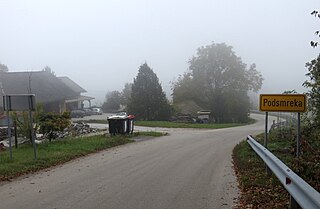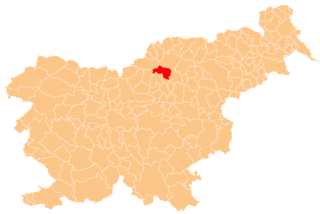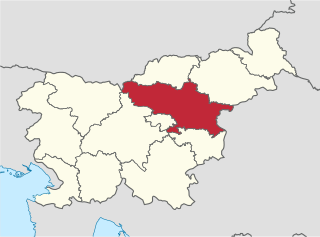
Gaberke is a settlement in the Municipality of Šoštanj in northern Slovenia. The area is part of the traditional region of Styria. The entire municipality is now included in the Savinja Statistical Region.

Brezje pri Lipoglavu is a small settlement in the hills southeast of Ljubljana in central Slovenia. It is part of the Ljubljana Urban Municipality. It lies in the traditional region of Lower Carniola and is now included with the rest of the municipality in the Central Slovenia Statistical Region.

Mali Vrh pri Prežganju is a small settlement in the hills east of Ljubljana, the capital of Slovenia. It belongs to the City Municipality of Ljubljana. The area was part of the traditional region of Lower Carniola and is now included with the rest of the municipality in the Central Slovenia Statistical Region.

Kal pri Dolah is a small settlement immediately north of Dole in the Municipality of Litija in central Slovenia. The area was traditionally part of the Lower Carniola region and is now included with the rest of the municipality in the Central Sava Statistical Region; until January 2014 the municipality was part of the Central Slovenia Statistical Region.

Družmirje is a settlement in the Municipality of Šoštanj in northern Slovenia. It lies just east of Šoštanj with much of its territory flooded after the collapse of abandoned shafts in the Šoštanj lignite mine. The area is part of the traditional region of Styria. The municipality is now included in the Savinja Statistical Region.

Florjan is a settlement in the Municipality of Šoštanj in northern Slovenia. The area was traditionally part of Styria. The municipality is now included in the Savinja Statistical Region.

Lokovica is a settlement in the Municipality of Šoštanj in northern Slovenia. It lies in the hills south of the town of Šoštanj. The area is part of the traditional region of Styria. The municipality is now included in the Savinja Statistical Region.

Ravne is a settlement in the Municipality of Šoštanj in northern Slovenia. It lies in the Mozirje Hills north of the town of Šoštanj. The area is part of the traditional region of Styria. The entire municipality is now included in the Savinja Statistical Region.

Šentvid pri Zavodnju is a dispersed settlement in the Municipality of Šoštanj in northern Slovenia. It lies in the Mozirje Hills northwest of the town of Šoštanj. The area is part of the traditional region of Styria. The entire municipality is now included in the Savinja Statistical Region.

Topolšica is a settlement in the Municipality of Šoštanj in northern Slovenia. The area is part of the traditional region of Styria. The municipality is now included in the Savinja Statistical Region. The Topolšica spa and the Topolšica Hospital are located in the settlement.

Zavodnje is a settlement in the Municipality of Šoštanj in northern Slovenia. The area is part of the traditional region of Styria. The municipality is now included in the Savinja Statistical Region.

Skorno is a settlement in the Municipality of Šmartno ob Paki in northern Slovenia. It lies in the hills above the right bank of the Paka River northwest of Šmartno. Traditionally the area was part of the Styria region. The entire Municipality of Šmartno ob Paki is now included in the Savinja Statistical Region.

Dol pri Trebnjem is a small settlement in the Municipality of Trebnje in eastern Slovenia. It lies just north of Trebnje itself, off the regional road leading to Mirna. The area is part of the historical region of Lower Carniola. The municipality is now included in the Southeast Slovenia Statistical Region.

Pristavica pri Velikem Gabru is a small settlement west of Bič in the Municipality of Trebnje in eastern Slovenia. The A2 Slovenian motorway runs along the southern edge of the settlement. The area is part of the historical region of Lower Carniola. The municipality is now included in the Southeast Slovenia Statistical Region.

Zagorica pri Čatežu is a small settlement south of Čatež in the Municipality of Trebnje in eastern Slovenia. The area is part of the historical region of Lower Carniola. The municipality is now included in the Southeast Slovenia Statistical Region.

Podsmreka pri Višnji Gori is a settlement east of Višnja Gora in the Municipality of Ivančna Gorica in central Slovenia. The area is part of the historical region of Lower Carniola. The municipality is now included in the Central Slovenia Statistical Region.

Češnjice pri Zagradcu is a settlement east of Zagradec in the Municipality of Ivančna Gorica in central Slovenia. The area is part of the historical region of Lower Carniola. The municipality is now included in the Central Slovenia Statistical Region.

The Municipality of Škocjan, established in October 1994, is a municipality in the traditional region of Lower Carniola in southeastern Slovenia. The seat of the municipality is Škocjan. The Municipality of Škocjan is now included in the Southeast Slovenia Statistical Region. The majority of the municipality is part of the Novo Mesto Administrative Unit, except for the northeastern part, which belongs to the Sevnica Administrative Unit.

The Municipality of Dol pri Ljubljani is a municipality in central Slovenia. The seat of the municipality is the settlement of Dol pri Ljubljani. It is part of the traditional region of Upper Carniola and is now included in the Central Slovenia Statistical Region.














